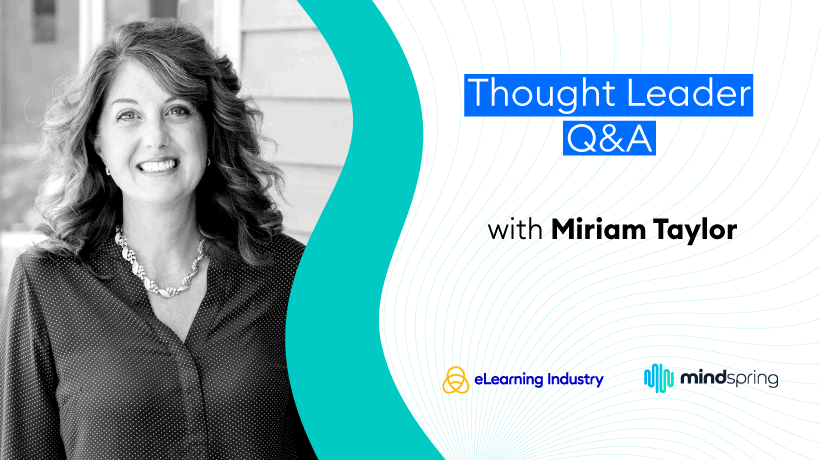Creating A Strategic Plan Of eLearning Action With Miriam Taylor
Miriam Taylor is the Learning Strategist in MindSpring. She has long-standing experience working in the L&D world, designing various digital learning experiences. Putting her knowledge into practice for development work, leadership training, and mentoring, she has helped K-12, nonprofits, and corporate organizations grow. Her most recent work is sharing her valuable insights through content writing, webinar hosting, and presenting conferences. Today, Miriam speaks with us about measuring learning impact, overcoming remote training challenges, and much more.
You were featured on the eLearning Industry’s Trailblazers list of top presenters. Based on your personal experience, do you have any tips to engage with your audience and form an instant connection?
One of the things I’ve learned with life experience is to always stay within myself when presenting. My style tends to be more informal. I seek to connect with the practitioner, to put myself in their shoes, and make sure they walk away with something practical because their time is precious. I also try to make a presentation fun or tell stories that inform and engage. I try to not take myself too seriously. That’s the tagline of our podcast for a reason. I hope I can always laugh at myself and recognize that I don’t know it all. I’m always looking to learn from my audience. These things might not work for everyone, but for me, they help me engage and more quickly form a personal connection with my audience.
What do you think is one of the most challenging aspects of creating personalized digital learning experiences for remote teams? Can you offer some words of wisdom to organizations that are considering making the switch from on-site to online training?
To begin, create a strategic plan. The challenge feels enormous, especially as we recover from emergency learning and understand better what works and doesn’t with a remote team.
This means, truly analyzing the opportunity and creating new learner profiles based on what you’ve learned from remote experiences, I’d perform a learner motivation analysis and gather some data.
Then, once you’ve done your research, you can create a curriculum map—basically a strategic plan of what content needs to go online first and how. It’s a roadmap that frees you from the tyranny of the urgent. It allows you to focus on what you know must be moved online first, because it’s backed by your research, but also you have a plan for the next year or more.
I’d also say that sometimes less is more. The curriculum map helps you determine current priorities, and the learner profile helps you best understand what they need. Maybe it doesn’t need to be a full-blown immersive learning experience. Maybe a short five-minute screencast will work with a job aid as a follow-up. And conversely, you can easily tell what learning initiatives need to become both high-priority and take the focus of most of your budget.
“Slowing down to speed up later” is my motto. In the world that we live in that might seem counterintuitive. However, for any learning professional who has spent most of their yearly budget on a learning initiative they later found didn’t meet the needs of the learners or the organization and was gathering dust on the proverbial shelf, you understand the importance of planning first.
Your “The Learning ScoreCard: Α Completely New Approach Τo Measuring Τhe ROI Οf Learning” event shed light on why measuring, tracking, and reporting ROI is vital to success. What is one of the most common mistakes organizations make when trying to gauge the true impact of L&D initiatives?
I would suggest that organizations don’t identify their KPIs early in their planning and building process. Too often, this gets overlooked. This is most likely because they lack the tools to measure, especially around behavior and ROI, so they don’t spend the necessary time making the business case. Setting up the system also requires some time, thought, and effort, but mainly I think it’s more about the inability to accurately measure and report. That’s why we invested the resources, time, and effort into the Learning ScoreCard to make this possible.
You have years of experience creating a diverse range of eLearning content. Are there a few helpful resources that you’d like to share with our readers?
- Designing for How People Learn by Julie Dirksen
- Learning Science for Instructional Designers by Clark N. Quinn
- Millennials, Goldfish & Other Training Misconceptions: Debunking Learning Myths and Superstitions by Clark N. Quinn. This is a simple, easy-to-reference guide that helps L&D professionals sift through fad, pop science, and real science.
- Streamlined ID: A Practical Guide to Instructional Design 2nd Edition by Miriam B. Larson and Barbara B. Lockee. This book introduces updates to ADDIE to include a more iterative approach.
I also make use of a lot of the eLI resources as well as ATD.
My last recommendation is whatever I read or learn I try to share with others. Either by volunteering for a lunch-and-learn lunch or a professional development time. We always extend our new knowledge, skills, and attitudes when we teach them to others.
Wrapping Up
Thanks to Miriam Taylor for participating in our Thought Leader Q&A. Miriam was featured on our eLearning Trailblazers: Presenters Who Engage And Enlighten and you can check out her LinkedIn profile to learn more about recommendations, experience, and insights.



